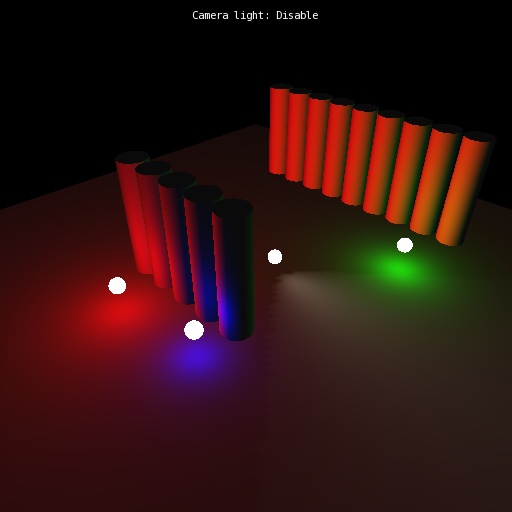This tutorial demonstrates how to use the following light types: directional lights, point lights, spot lights, how to animate the position and direction of a light and how to attach a light to a camera.

[From App_Lights.cpp]
class App_Lights: public BaseDemo { public: virtual void initEvent() { vl::Log::notify(appletInfo()); mCameraLightType = Disable; // setup our simple scene with a plane and a few columns mLightFx = new vl::Effect; mLightFx->shader()->enable(vl::EN_LIGHTING); /* IMPORTANT! */ mLightFx->shader()->enable(vl::EN_DEPTH_TEST); vl::ref<vl::Geometry> ground = vl::makeGrid( vl::vec3(0,0,0), 20, 20, 100,100 ); ground->computeNormals(); sceneManager()->tree()->addActor(ground.get(), mLightFx.get()); for(int i=0; i<9; ++i) { vl::ref<vl::Geometry> pillar = vl::makeCylinder( vl::vec3(6,2,-4*1.1f + i*1.1f), 1, 4, 100, 100, true, false); pillar->computeNormals(); sceneManager()->tree()->addActor(pillar.get(), mLightFx.get()); } for(int i=0; i<5; ++i) { vl::ref<vl::Geometry> pillar = vl::makeCylinder( vl::vec3(-3,2,-2*1.1f + i*1.1f), 1, 4, 100, 100, true, false); pillar->computeNormals(); sceneManager()->tree()->addActor(pillar.get(), mLightFx.get()); } // light setup // A typical OpenGL implementation supports up to 8 lights at the same time. It means that your scene can have // as many lights as you want but each object can be lit "only" by 8 lights at a time, this is usually never the // case as lighting absorbs considerable computational resources. // In our example each object will be lit up to 5 lights at the same time. mLight0 = new vl::Light; mLight1 = new vl::Light; mLight2 = new vl::Light; mLight3 = new vl::Light; mLight4 = new vl::Light; // Add the lights to the shader in order to use them (we save light #4 for the camera) mLightFx->shader()->setRenderState( mLight0.get(), 0 ); mLightFx->shader()->setRenderState( mLight1.get(), 1 ); mLightFx->shader()->setRenderState( mLight2.get(), 2 ); mLightFx->shader()->setRenderState( mLight3.get(), 3 ); // Define the light diffuse color. // See the OpenGL Programmer's Guide for more details about the OpenGL lighting model and equations. mLight0->setDiffuse(vl::red); mLight1->setDiffuse(vl::green); mLight2->setDiffuse(vl::blue); mLight3->setDiffuse(vl::white); mLight4->setDiffuse(vl::white); // Setup lights #0, #1 and #2 as positional lights with constant, linear and quadratic attenuation. // Again, see the OpenGL Programmer's Guide for more details about the OpenGL lighting model and equations. mLight0->setPosition(vl::fvec4(0,0,0,1)); /* default */ mLight0->setConstantAttenuation(1.0f); mLight0->setLinearAttenuation(0.0f); mLight0->setQuadraticAttenuation(0.0f); mLight1->setPosition(vl::fvec4(0,0,0,1)); /* default */ mLight1->setConstantAttenuation(0.0f); mLight1->setLinearAttenuation(1.0f); mLight1->setQuadraticAttenuation(0.0f); mLight2->setPosition(vl::fvec4(0,0,0,1)); /* default */ mLight2->setConstantAttenuation(0.0f); mLight2->setLinearAttenuation(0.0f); mLight2->setQuadraticAttenuation(1.0f); // Setup light #3 as a spot light. // Valid values are from 0.0f to 90.0f plus the special value 180.0f (default) which disables the spot lighting. mLight3->setSpotCutoff(45.0f); mLight3->setSpotExponent(5.0f); mLight3->setSpotDirection(vl::fvec3(1,0,0)); // A spot light is essentially a special positional light so these apply to spot lights as well. mLight3->setConstantAttenuation(1.0f); mLight3->setLinearAttenuation(0.0f); mLight3->setQuadraticAttenuation(0.0f); // Setup light's Transform to animate them mLight0_Transform = new vl::Transform; mLight1_Transform = new vl::Transform; mLight2_Transform = new vl::Transform; mLight3_Transform = new vl::Transform; rendering()->as<vl::Rendering>()->transform()->addChild(mLight0_Transform.get()); rendering()->as<vl::Rendering>()->transform()->addChild(mLight1_Transform.get()); rendering()->as<vl::Rendering>()->transform()->addChild(mLight2_Transform.get()); rendering()->as<vl::Rendering>()->transform()->addChild(mLight3_Transform.get()); // light 0..3 follow the relative transform mLight0->bindTransform(mLight0_Transform.get()); mLight1->bindTransform(mLight1_Transform.get()); mLight2->bindTransform(mLight2_Transform.get()); mLight3->bindTransform(mLight3_Transform.get()); // light 4 follows the camera mLight4->bindTransform(NULL); // add a white sphere for each light to have a better visual feedback of the light animation. vl::ref<vl::Geometry> bulb = vl::makeUVSphere(vl::vec3(0,0,0), 0.5f); vl::ref<vl::Effect> bulb_fx = new vl::Effect; bulb_fx->shader()->enable(vl::EN_DEPTH_TEST); bulb_fx->shader()->gocColor()->setValue(vl::white); sceneManager()->tree()->addActor(bulb.get(), bulb_fx.get(), mLight0_Transform.get()); sceneManager()->tree()->addActor(bulb.get(), bulb_fx.get(), mLight1_Transform.get()); sceneManager()->tree()->addActor(bulb.get(), bulb_fx.get(), mLight2_Transform.get()); sceneManager()->tree()->addActor(bulb.get(), bulb_fx.get(), mLight3_Transform.get()); // Simple text to inform the user of the currently active light setup. vl::ref<vl::Effect> text_fx = new vl::Effect; text_fx->shader()->enable(vl::EN_BLEND); mText = new vl::Text; mText->setFont( vl::defFontManager()->acquireFont("/font/bitstream-vera/VeraMono.ttf", 8) ); mText->setAlignment( vl::AlignHCenter | vl::AlignTop ); mText->setViewportAlignment( vl::AlignHCenter | vl::AlignTop ); mText->translate(0,-10,0); sceneManager()->tree()->addActor(mText.get(), text_fx.get()); updateText(); } void updateText() { switch(mCameraLightType) { case Disable: mText->setText("Camera light: Disable"); break; case DirectionalLight: mText->setText("Camera light: Directional Light"); break; case PositionalLight: mText->setText("Camera light: Positional Light"); break; case SpotLight: mText->setText("Camera light: Spot Light"); break; } } // Pressing space we cycle around 4 different light setup for light #4 (the one following the camera) void keyPressEvent(unsigned short ch, vl::EKey key) { BaseDemo::keyPressEvent(ch, key); if (key == vl::Key_Space) { mCameraLightType = (ECameraLightType)((mCameraLightType+1)%4); switch(mCameraLightType) { case Disable: // removes light #4 from the Shader mLightFx->shader()->eraseRenderState(mLight4.get(), 4); // you can also do: // mLightFx->shader()->removeRenderState(vl::RS_Light4); // or even // mLightFx->shader()->removeRenderState(vl::Light(4).type()); break; case DirectionalLight: // add the light to the shader mLightFx->shader()->setRenderState(mLight4.get(), 4); // since the fourth component is 0 OpenGL considers this a direction mLight4->setPosition(vl::fvec4(0,0,1,0)); // disable spot light mLight4->setSpotCutoff(180.0f); break; case PositionalLight: // add the light to the shader (just for clarity) mLightFx->shader()->setRenderState(mLight4.get(), 4); // since the fourth component is 1 OpenGL considers this a position mLight4->setPosition(vl::fvec4(0,0,0,1)); // positional light attenuation mLight4->setConstantAttenuation(1.0f); mLight4->setLinearAttenuation(0.0f); mLight4->setQuadraticAttenuation(0.0f); // disable spot light mLight4->setSpotCutoff(180.0f); break; case SpotLight: // add the light to the shader (just for clarity) mLightFx->shader()->setRenderState(mLight4.get(), 4); // since the fourth component is 1 OpenGL considers this a position mLight4->setPosition(vl::fvec4(0,0,0,1)); // positional light attenuation mLight4->setConstantAttenuation(1.0f); mLight4->setLinearAttenuation(0.0f); mLight4->setQuadraticAttenuation(0.0f); // enable and setup spot light mLight4->setSpotCutoff(25.0f); mLight4->setSpotExponent(40.0f); mLight4->setSpotDirection(vl::fvec3(0,0,-1)); break; } } updateText(); } // Animate the lights virtual void updateScene() { vl::real phase = 120.0f; vl::mat4 m; m.translate(5,1,0); m.rotate( phase*0.0f + 1.0f*vl::Time::currentTime()*vl::fPi*15, 0, 1.0f, 0); mLight0_Transform->setLocalMatrix(m); m.setIdentity(); m.translate(5,1,0); m.rotate( phase*1.0f + 1.3f*vl::Time::currentTime()*vl::fPi*15, 0, 1.0f, 0); mLight1_Transform->setLocalMatrix(m); m.setIdentity(); m.translate(5,1,0); m.rotate( phase*2.0f + 1.7f*vl::Time::currentTime()*vl::fPi*15, 0, 1.0f, 0); mLight2_Transform->setLocalMatrix(m); m.setIdentity(); m.translate( sin(vl::Time::currentTime()*vl::fPi),0.5f,0); m.rotate( 0.5f*vl::Time::currentTime()*vl::fPi*15, 0, 1.0f, 0); mLight3_Transform->setLocalMatrix(m); } protected: vl::ref< vl::Light > mLight0; vl::ref< vl::Light > mLight1; vl::ref< vl::Light > mLight2; vl::ref< vl::Light > mLight3; vl::ref< vl::Light > mLight4; vl::ref< vl::Transform > mLight0_Transform; vl::ref< vl::Transform > mLight1_Transform; vl::ref< vl::Transform > mLight2_Transform; vl::ref< vl::Transform > mLight3_Transform; vl::ref< vl::Effect > mLightFx; vl::ref< vl::Text > mText; enum ECameraLightType { Disable, DirectionalLight, PositionalLight, SpotLight } mCameraLightType; }; // Have fun!